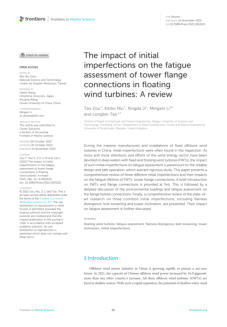Underwater construction 2022



Authors:
Anudipta Chaudhuri, Rajkanya Datta, Muthuselvan
Praveen Kumar, João Paulo Davim, and Sumit Pramanik.
The demand for a modern wind energy conversion
system (WECS) has increased to achieve a suitable
alternate renewable energy source. In this paper, after a
brief introduction, the classification of WECS is reviewed
with attractive illustrations. The various mechanical
materials and electrical components of WECS are
discussed. The flow of power in WECS and its control
strategies are also described. The wind energy conversion
is carried out with a suitable controlling mechanism for
power grid integration.



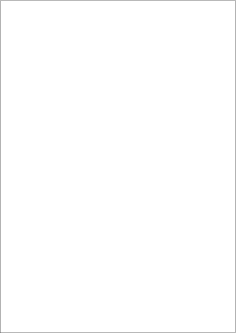
Authors:
Marco Civera, & Cecilia Surace
A complete surveillance strategy for wind turbines
requires both condition monitoring (CM) of their
mechanical components and the structural health
monitoring (SHM) of their load-bearing structural
elements (foundations, tower, and blades). Therefore, it
spans both the civil and mechanical engineering fields.
Several traditional and advanced non-destructive
techniques (NDTs) have been proposed for both areas of
application throughout the last years. This document
extensively reviews these non-destructive approaches;
more than 300 scientific articles, technical reports, and
other documents are included in this review,
encompassing all the main aspects of these survey
strategies.


Authors:
Jun Yu, Jian-hu Liu, Hai-kun Wang, Jun Wang, Zhang-tao
Zhou, and Hai-bin Mao
Underwater explosion cavitation is generally simulated
using a one-fluid model based on compressible
multicomponent flows. Owing to the lack of mass and
heat transfer between liquid and vapor phases, this model
is incapable of extensively analyzing the cavitation
mechanism in an underwater explosion. In this study, the
authors extend the phase transition model provided by
Chiapolino et al. to the field of underwater explosion
cavitation. The model presents a more accurate
description of the thermodynamics of cavitation processes
involving liquid–vapor phase transition.
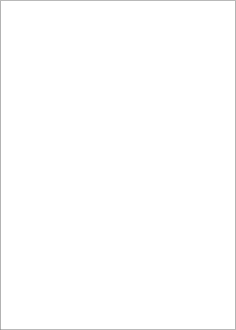
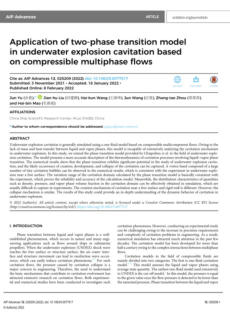

Authors: Y. Zhang, Y.D. Zhou, H. Wu
With the increasing significance of marine safety issues,
the studies on the underwater blast-resistant performance
of wharves, e.g., reinforced concrete (RC) caissons, has
become an urgent demand. At present, the influence of
water level on caisson subjected to underwater explosions
was studied experimentally and numerically, e.g.,
underwater explosion loading characteristics and dynamic
behaviors of caisson. Firstly, four shots of underwater
explosion test were carried out both in free field and on a
partially submerged caisson specimen, and the
overpressure and deflection-time histories, as well as the
structural damage pattern were recorded.

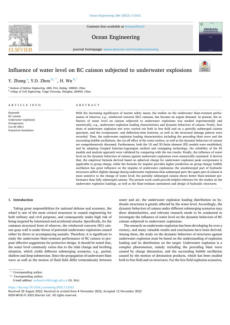

Authors:
Xieping Huang, Xiangzhen Kong, Jing Hu, Qin Fang
The small-scale model test is the major affordable
approach to experimentally investigate concrete gravity
dams against underwater explosions. However, results of
the small-scale model should be properly converted to the
prototype, which requires the knowledge of scaling law.
This study presented the scaling of failures of concrete
gravity dams against underwater explosion shock loading
through small-scale centrifuge tests and numerical
simulations.

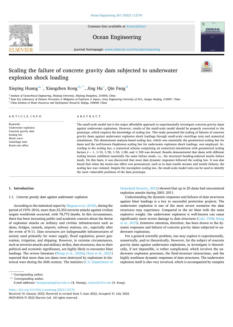

Authors:
Jun Yu, Wen-Wei Wu, Jiu-Ting Dong, and Xian-Pi Zhang
Although the cavitation phenomenon in underwater
explosions has been researched for more than 100 years,
the phase transition models based on mass and heat
exchange between liquid and its vapor phases have only
been established in the past decade. In this study, the
secondary cavitation phenomenon was first captured by
phase transition based on a four-equation system.

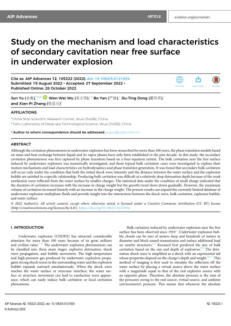

Authors:
Elizabeth L. Freeman, Kristen D. Splinter, Ron J. Cox and
Francois Flocard
Piled floating pontoons are public access structures that
provide a link between land and sea. Despite floating
pontoons being frequented by the public, there is limited
data available to coastal or maritime engineers detailing
the dynamic motions (acceleration and rotation) of these
structures under wave action and the impact of these
motions on public comfort and safety to inform their
design. This contribution summarizes results from a set of
laboratory-scale physical model experiments of two
varying beam width piled floating pontoons subjected to
boat wake conditions.

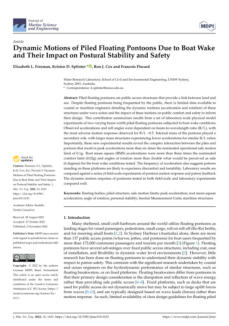

Authors: Zhicheng Zhang, Yanbiao Zhao, Nansha Gao
Based on the recent development of underwater sound
absorption coatings, this paper analyzes the evolution of
underwater sound absorption coatings from two aspects:
traditional structures and metamaterials.

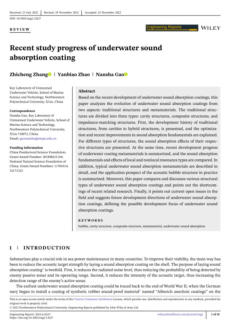

Authors: Jiahui Cui, Nguyen Duc Van, Feng Zhang, and
Yukio Hama
This paper evaluates the applicability of the minimum
required compressive strength for cold weather
concreting based on winter meteorological factors. This
study performed a compressive strength test, dynamic
elastic modulus test, hydration degree test, underwater
weighing test, and freeze-thaw test to investigate the
effect of compressive strength development at early ages
on the frost resistance of concrete.



Authors:
Dian-Long Wang, Chao-Sheng Tang , Xiao-Hua Pan, Rui
Wang , Jian-Wen Li b, Zhi-Hao Dong, Bin Shi)
Bio-carbonation of reactive magnesia cement (RMC) is a
sustainable cementing technology used to stabilize
construction and demolition wastes (CDW) in underwater
engineering projects. Experiments showed that bio-
carbonation of recycled masonry concrete effectively
stabilized construction and demolition waste underwater,
resulting in a significant increase in unconfined
compressive strength (UCS).

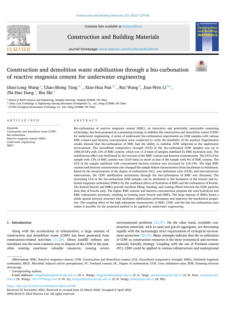


Authors: Grzegorz Rutkowski, Paweł Kołakowski, and
Katarzyna Panasiuk
Batychron is a device used in underwater engineering for
safe transportation and diving. This study focuses on
strength tests and analysis of the best method to join
thermoplastic polyurethane film (TPU) and polypropylene
belts for underwater use to obtain a specific buoyancy
force.
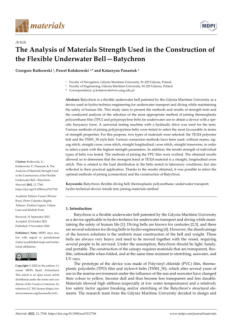

Authors:
Xiao-Ping Zhang, Shao-Hui Tang, Quan-Sheng Liu, Hao-
Jie Wang, Xin-Fang Li, Peng Chen, Hao Liu
This study analyzed the complexity of the first underwater
gas-insulated transmission line for 1000 kV power, the
Sutong GIL Yangtze River Crossing Cable Tunnel.
Engineering challenges during construction and
inspection were discussed. Key technologies developed
include embankment deformation control, gas explosion
prevention, synchronous transportation organization,
dust-free equipment installation, and robot intelligent
inspection.

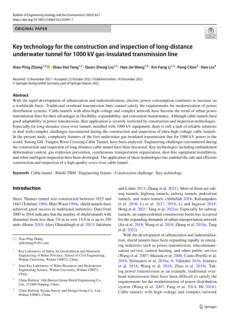


Click on the
octopus to return to
the top of the page

Authors: Chen Fabo, He Ben, Gao Peng, Ge Xiangming,
Zhou Yong, & Chu Weijiang
This document provides insights into the impact of
installation platforms on the bearing capacity and
structural integrity of monopile foundations used in
offshore constructions. It highlights the necessity of
considering installation disturbances in the design process
to optimize construction costs and enhance safety. It
presents findings from a sensitivity analysis based on
numerical simulations, detailing the specific reductions in
bearing capacities and increases in displacements and
internal forces due to the installation platform's support
legs.

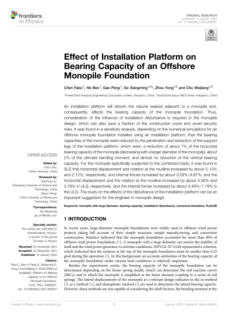

Authors:
Yuan Ma, Chaohe Chen, Tianhui Fan, and Hongchao Lu
This document explains the challenges floating offshore
wind turbines (FOWTs) face due to greater wind heeling
moments, which cause significant pitch motion and affect
structural safety and power generation efficiency. It
highlights the limitations of conventional mooring
systems, which primarily resist horizontal motion, and
introduces a new mooring system that addresses both
pitch and horizontal motion by dividing the fairleads into
two groups at different depths. It also mentions the
comparative analysis of motion responses, structural loads,
and restoring forces between the conventional and
innovative mooring systems.

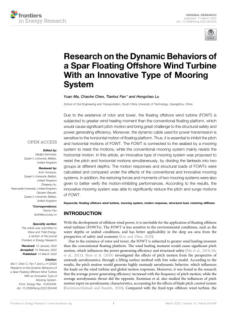

Authors:
Daniel Flórez-Orrego, Cyro Albuquerque, Julio A. M. Da
Silva, Ronaldo Freire, & Silvio De Oliveira Junior
This paper compares existing cogeneration systems versus
alternative power hub setups for floating production,
storage, and offloading units (FPSOs) in the offshore oil
and gas sector. It highlights the potential benefits of
adopting centralized offshore power stations, such as
increased revenues, optimal sizing, and reduced idle
power units, while also discussing the challenges and
trade-offs related to economic feasibility, environmental
impact, and operational efficiency.

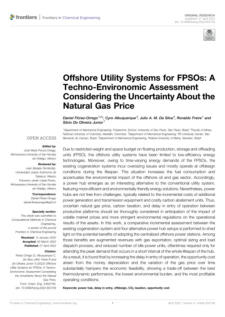

Authors: Riccardo Maria Pulselli, Matteo Maccanti, Morena
Bruno, Alessio Sabbetta, Elena Neri, Nicoletta
Patrizi, & Simone Bastianoni
This article discusses a Life Cycle Assessment (LCA) study
on the environmental performance of two types of
floating wind turbines (raft-buoy and spar-buoy) used in
offshore wind farms in the Mediterranean. The study aims
to establish a benchmark for evaluating the greenhouse
gas emissions (measured in terms of Global Warming
Potential) of these turbines, thereby aiding in the design
and validation of innovative technologies for offshore
wind energy. The results indicate that floating wind
turbines have a carbon intensity comparable to other
renewable energy sources.

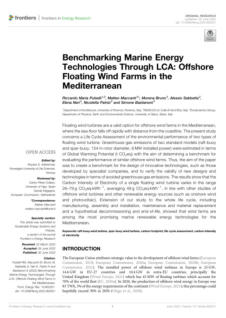

Authors: Sahil Tadwalkar, Yujin Lee, and Martin Fischer
This paper investigates the current state of prefabricated
pipe spools in the construction industry, identifies
challenges associated with their implementation, and
proposes a standardized workflow to address these
challenges. It includes findings from interviews with
industry professionals and emphasizes the need for better
integration between design, fabrication, and
transportation to improve efficiency.



Authors: Dimitrios N. Konispoliatis, Dimitrios I. Manolas,
Spyros G. Voutsinas, & Spyros A. Mavrakos
This article presents a detailed analysis of a multi-purpose
floating structure designed for offshore wind and wave
energy exploitation. It describes the coupled analysis
performed in both frequency and time domains,
considering various factors such as hydrodynamic
interactions, mooring lines, Oscillating Water Column
(OWC) characteristics, and wind turbine aerodynamics. It
also provides numerical results on the structure's
hydrodynamic properties and load conditions and
investigate the impact of different installation sites on
these loads.

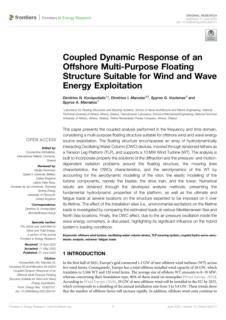


Authors: Fenghua Zhou, Rongwang Zhang, and Shaowei
Zhang
This article describes the design, implementation, and
functionality of a low-cost directional inertial wave sensor,
DWS19-2, outlining its integration with specific hardware
components, its capability to measure various buoy
parameters, and its application in calculating wave
parameters and spectra. Additionally, it mentions the
reporting of this data for real-time transmission and
provides details on the electrical design, onboard
processing algorithms, and validation tests conducted.
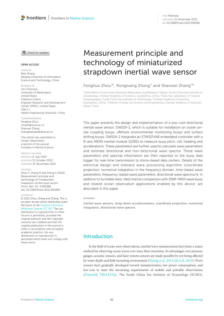


Authors: Z G Kornilova, G S Ammosov, D S Ivanov
This text discusses the impact of construction activities,
specifically the laying of underwater pipeline crossings, on
the turbidity and sediment dynamics of the Lena River. It
highlights the environmental and structural challenges
posed by these activities, such as increased water turbidity,
sediment discharge, and potential damage to the pipeline
due to erosion and hydrodynamic loads. It also
emphasizes the need for further studies to evaluate the
ecological impact on the river.
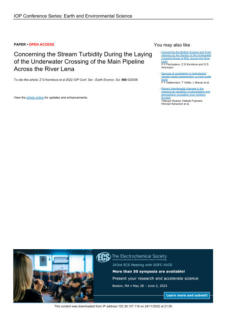









04 - A Comparative Analysis of the Characteristics of Platform Motion
of a Floating Offshore Wind Turbine Based on Pitch Controllers.
Authors: Chan Roh , Yoon-Jin Ha, Hyeon-Jeong Ahn,
and Kyong-Hwan Kim
The installation of fixed offshore wind power systems at
deeper waters needs a floating foundation, which brings
challenges. This study looks at the platform motion of a
floating offshore wind turbine system using different pitch
controllers. An effective pitch controller is recommended,
which reduces platform movement and improves output.
The developed system features an NREL 5-MW turbine
and an OC4 semi-submersible platform, evaluated using
FAST-v8. The results show a 0. 42% output increase and a
19. 3% decrease in output variability due to reduced
platform motion.
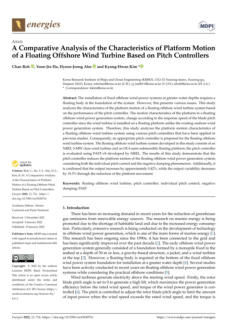



10 - Design and analysis of semi-submersible offshore floating wind
and photovoltaic platforms
Author: Junwei Qiu
The ocean has great potential for green energy but
current floating offshore systems are limited. This paper
designs a semi-submersible platform combining wind and
solar power, calculating various loads and costs for
effective renewable energy implementation.
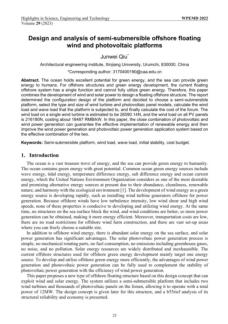



11 - Polarization Reconstruction Algorithm of Target Based on the
Analysis of Noise in Complex Underwater Environment.
Authors: Qiang Song, Xiao Liu, Honglian Huang, Rufang
Ti, and Xiaobing Sun
This paper discusses methods to reduce interference like
scattering, absorption, and attenuation in underwater
photoelectric detection. It studies polarization-imaging
recovery through radiation transfer theory and
simulations. It analyzes scattering of underwater particles,
constructs a polarization reconstruction model, and builds
a polarization imaging system, achieving better resolution
and contrast than traditional methods.
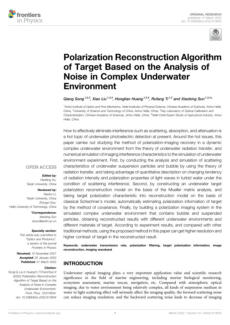



15 - Analysis of thrust blocks systems: Pipeline, soil and foundation
interaction
Authors: Josefina Barrera, Franco Carpio , Alberto Jaime,
Fernando Pena, Alejandro Sanchez
This study evaluates the behavior of a discharge manifold
with space restrictions, which complicates design. An
upgraded methodology for structural analysis was
developed, considering soil-thrust blocks-pipeline
interaction. Two analyses were performed, showing
increased capacity when considering interactions.
Reducers outside the blocks significantly raise pipeline
stresses, yet the manifold is suitable for operation. The
enhanced methodology is recommended for evaluating
similar manifolds.


Authors: Sahil Thakur
Ocean waves are a major renewable energy source that
can reduce fossil fuel use. A hybrid offshore platform can
harness this energy year-round. This paper explains the
platform's working principle and addresses inefficiencies
of independent devices that discourage investment. It
suggests combining different renewable energy devices
for more stable electricity production. The hybrid
platforms are still in development or testing stages. The
paper evaluates the design and feasibility of constructing
such a platform.


16 - Hybrid offshore wave energy platform
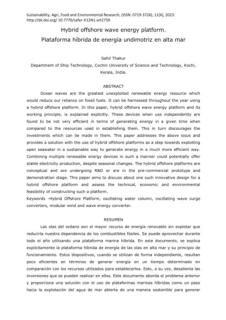



27 - Design of a Structural Health Monitoring System and
Performance Evaluation for a Jacket Offshore Platform in East
China Sea.

Authors: Hailin Ye, Chuwei Jiang, Feng Zu, and
Suzhen Li
Offshore platforms are crucial for ocean strategies, and
building a structural health monitoring (SHM) system can
enhance their safety. This paper outlines a complete SHM
system design consisting of various subsystems. It also
examines an offshore platform's performance, addressing
issues like scouring and corrosion. This work serves as a
guide for SHM system installation on offshore platforms.
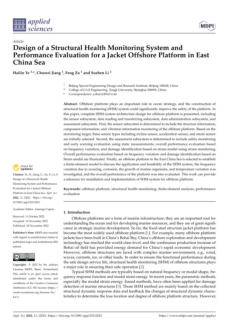



09 - Structural Analysis and Experimental Study on the Spherical Seal
of a Subsea Connector Based on a Non-Standard O-Ring Seal
Authors: Dong Liu, Feihong Yun, Kefeng Jiao, Liquan
Wang, Zheping Yan, Peng Jia, Xiangyu Wang,
Weifeng Liu, Xiaoquan Hao, and Xiujun Xu
This study investigates the use of a non-standard spherical
sealing structure using O-rings in underwater oil and gas
pipelines. The connector compensates for alignment
differences and angle offsets during docking. The
structure of the groove was designed and analyzed using
nonlinear theory. The authors also examined the effects of
pressures and compression ratios on the O-ring sealing
performance. This theoretical analysis was validated
through testing, proving it can maintain a good seal
under high pressure.
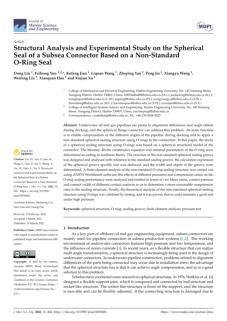



17 - Methodology of Leakage Prediction in Gasketed Flange Joints
at Pipeline Deformations
Author: Przemysław Jaszak, Janusz Skrzypacz, Andrzej
Borawski, and Rafał Grzejda
This paper proposes a leakage prediction method for
flange joints after pipeline deformation using FEM (Finite
Element Methods). It details the design stages and a multi-
stage load application method. Experiments show that
minor pipeline deflection increases gasket circumferential
pressure and affects stress determination, and in addition,
the distribution of contact pressure also influences leakage
levels. The results are compared to numerical calculations,
proving the assumptions made in the numerical model
correct.
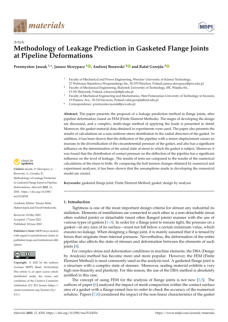


24 - The impact of initial imperfections on the fatigue assessment of
tower flange connections in floating wind turbines: A review
Authors: Tao Zou, Xinbo Niu, Xingda Ji, Mingxin Li, and
Longbin Tao
This paper reviews three initial imperfections in fixed
offshore wind turbines (FWTs) and their impact on
fatigue assessment. It discusses environmental loadings
and fatigue assessment on FWTs' bolted connections,
and reviews state-of-the-art research on fatigue
divergence, bolt loosening, and tower inclination. It also
emphasizes the importance of rigorous study for reliable
design and safe operation in deep waters.
